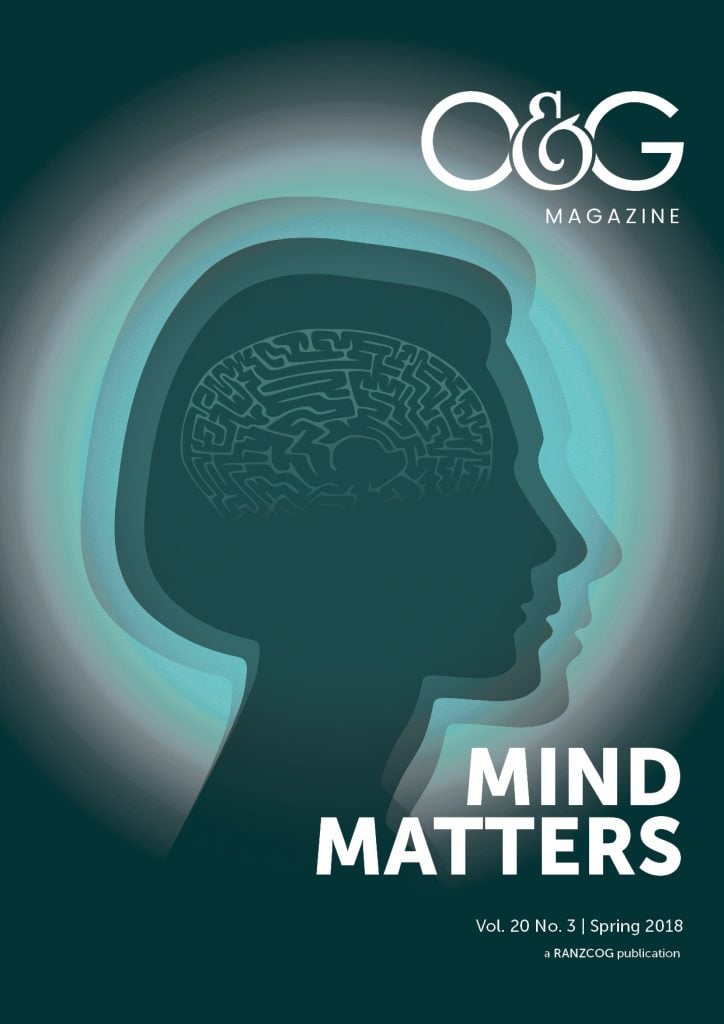ANZJOG issues for June and August 2018 should be in the hands of readers by the time of publication of this issue of O&G Magazine.
In the June issue, both an editorial by Saville, and an article by Paul et al entitled ‘Outcomes for women without conventional treatment for stage 1A (microinvasive) cancer of the cervix’, deal with contentious historical material from the ‘unfortunate experiment’ in Auckland in the mid-20th century.1 2 Cong et al find that previous caesarean section at full dilatation increases the risk of subsequent preterm birth,3 and Michelotti et al describe the impact of shoulder dystocia on neonatal and maternal morbidity.4 There is also an interesting report from Hyland and associates on the first 1000 patients using an Australian direct-to-patient telemedicine service for the provision of early medical abortion.5 In the Current Controversies series, Chan and Munro argue for and against the case for robotically assisted gynaecological surgery, including a piece entitled ‘It’s not a robot, and it doesn’t make anything better’.6 7
The August issue contains several articles on the topic of non-invasive prenatal testing for fetal aneuploidy in the cell-free DNA era,8 including an editorial from Maxwell and O’Leary,9 and a Clinical Perspective Frequently Asked Questions from Rieder et al.10 There are three further stimulating pieces on the topic of robotically assisted gynaecological surgery, including the Current Controversy replies from Chan and Munro.11 12 Also of interest is an update to Australian and New Zealand guidelines on the care of women with decreased fetal movements.13
The 2017 Journal Citation Report was released by our publishers Wiley on 26 June 2018. I am happy to let you know that the 2017 Impact Factor for ANZJOG has risen to 1.766 (from 1.607 in 2016). This result places the journal 53/82 in the Obstetrics and Gynaecology category. The rise in the Impact Factor is probably due to publication of the SOMANZ Guidelines on hypertension and other guidelines, and to the increased volume of opinion and Letters to the Editor, including the Current Controversies.
We continued to receive a large number of submissions in the first half of 2018, around 230 to date. About 40 per cent are direct rejections by the Editor or, occasionally, by the Publications Coordinator, if the manuscript demonstrably lies outside the author guidelines. The remainder are sent for full peer review and around half of these are ultimately accepted for publication. The Opinion section continues to be well subscribed (high-quality evidence-based opinion), particularly in the Current Controversies series, and is well received by the readership.
The author guidelines are currently being reviewed by the Associate and Assistant Editors. I am expecting to add greater stringency in regard to word count and limitations on tables and figures adhered to. We will also have another category of Specialist Society Guidelines, as these are in high demand by the readership. We will be emphasising the use of UK spelling and the inclusion of details of ethics approval (or in the absence of, need for formal ethics approval in some cases of retrospective use of de-identified data collection) within the Materials and Methods section of all original research articles, including short communications. As always, I would welcome further suggestions for topics for the Current Controversies.
To coincide with the RANZCOG 2018 ASM in September in Adelaide, ANZJOG will be publishing a special free-access ’virtual’ online edition of the journal, concerned with Indigenous women’s reproductive health. This will be edited by Dr Marilyn Clarke, Chair of the Indigenous Women’s Health Committee. I am grateful to Wiley for making this issue possible.
References
- Saville M, McNally O. ‘Lest we forget’ as we move forward with cervical screening. ANZJOG 2018 Jun;58(3):265.
- Paul C, Sharples KJ, Baranyai J, et al. Outcomes for women without conventional treatment for stage 1A (microinvasive) carcinoma of the cervix. ANZJOG 2018 Jun;58(3):321.
- Cong A, de Vries B, Ludlow J. Does previous caesarean section at full dilatation increase the likelihood of subsequent spontaneous preterm birth? ANZJOG 2018 Jun;58(3):267.
- Michelotti F, Flatley C, Kumar S. Impact of shoulder dystocia, stratified by type of manoeuvre, on severe neonatal outcome and maternal morbidity. ANZJOG 2018 Jun;58(3):298.
- Hyland P, Raymond EG, Chong E. A direct-to-patient telemedicine abortion service in Australia: Retrospective analysis of the first 18 months. ANZJOG 2018 Jun;58(3):335.
- Chan F. Robotic-assisted surgical procedures are the future of gynaecology in Australasia. ANZJOG 2018 Jun;58(3):371.
- Munro MG. The surgical ‘Robot’ in gynaecology: It isn’t a robot at all and it doesn’t make anything better. ANZJOG 2018 Jun; 58(3):375.
- Hui L, Barclay J, Poulton A, et al. Prenatal diagnosis and socioeconomic status in the non-invasive prenatal testing era: a population-based study. ANZJOG 2018 Aug;58(4):404.
- Maxwell S, O’Leary P. Public funding for non-invasive prenatal testing for fetal aneuploidy – it’s time. ANZJOG 2018 Aug; 58(4):385.
- Rieder W, White S, McGillivray G, Hui L. Contemporary prenatal aneuploidy screening practice? In Australia: Frequently asked questions in the cell-free DNA era. ANZJOG 2018 Aug;58(4):397.
- Chan F. Right of reply to: The surgical ‘Robot’ in gynaecology: It isn’t a robot at all and it doesn’t make anything better. ANZJOG 2018 Aug;58(4):478.
- Munro MG. Right of reply to: Robotic-assisted surgical procedures are the future of gynaecology in Australasia. ANZJOG 2018 Aug;58(4):480.
- Daly LM, Gardener G, Bowring V, et al. Care of pregnant women with decreased fetal movements: update of a clinical practice guideline for Australia and New Zealand. ANZJOG 2018 Aug; 58(4):463.






Leave a Reply